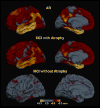Neuroimaging enrichment strategy for secondary prevention trials in Alzheimer disease
- PMID: 20683184
- PMCID: PMC2929320
- DOI: 10.1097/WAD.0b013e3181d1b814
Neuroimaging enrichment strategy for secondary prevention trials in Alzheimer disease
Abstract
We examined the improvement in statistical power that could be obtained in therapeutic trials for early (predementia) Alzheimer disease by constraining enrollment to individuals with amnestic mild cognitive impairment (MCI) and an atrophy pattern on a screening magnetic resonance imaging (MRI) scan previously found to be predictive of clinical decline, or to individuals with MCI and the apolipoprotein E epsilon 4 genetic risk factor for Alzheimer disease. Treatable effects were defined as absolute change versus change relative to healthy controls (HCs). Data from 168 HC and 299 MCI participants were analyzed to determine sample sizes required to detect 25% slowing in mean rate of decline using global function, cognitive function, and structural measures as outcome variables. Reductions in estimated sample sizes of 10% to 43% were observed using the genetic enrichment strategy; reductions of 43% to 60% were observed with the neuroimaging enrichment strategy. Sample sizes needed to detect slowing in rate of atrophy in MCI relative to HC were dramatically larger than those needed to detect absolute change in atrophy rates. Constraining enrollment to MCI subjects with predictive atrophy on a screening MRI scan could improve the efficiency of clinical trials. Failure to take into account normal age-related changes risks under-powering trials designed to test disease-modifying properties of potential treatments.
Conflict of interest statement
Figures



References
-
- Petersen RC, Bennett D. Mild cognitive impairment: is it Alzheimer’s disease or not? J Alzheimers Dis. 2005;7:241–5. discussion 255-62. - PubMed
-
- Morris JC, Storandt M, Miller JP, et al. Mild cognitive impairment represents early-stage Alzheimer disease. Arch Neurol. 2001;58:397–405. - PubMed
-
- Petersen RC. Mild cognitive impairment as a diagnostic entity. J Intern Med. 2004;256:183–94. - PubMed
-
- Petersen RC, Thomas RG, Grundman M, et al. Vitamin E and donepezil for the treatment of mild cognitive impairment. N Engl J Med. 2005;352:2379–88. - PubMed
Publication types
MeSH terms
Substances
Grants and funding
- U24 RR021382/RR/NCRR NIH HHS/United States
- U01 AG0-10483/AG/NIA NIH HHS/United States
- K01AG029218/AG/NIA NIH HHS/United States
- #U24 RR021382/RR/NCRR NIH HHS/United States
- R03 AG034439/AG/NIA NIH HHS/United States
- U01 AG010483/AG/NIA NIH HHS/United States
- R03AG034439/AG/NIA NIH HHS/United States
- AG031224/AG/NIA NIH HHS/United States
- K01 AG029218/AG/NIA NIH HHS/United States
- U01 AG0-24904/AG/NIA NIH HHS/United States
- R01 AG031224/AG/NIA NIH HHS/United States
- U01 AG024904/AG/NIA NIH HHS/United States
- U19 AG010483/AG/NIA NIH HHS/United States
LinkOut - more resources
Full Text Sources
Medical

